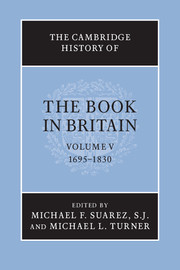Book contents
- Frontmatter
- Introduction
- PART I THE QUANTITY AND NATURE OF PRINTED MATTER
- PART II ECONOMIC, LEGAL AND CULTURAL CONTEXTS
- PART III THE TECHNOLOGIES AND AESTHETICS OF BOOK PRODUCTION
- PART IV THE BOOK TRADE AND ITS MARKETS
- I LONDON AND THE ‘COUNTRY’
- II TWO CASE STUDIES
- 18 Richard Francklin: a controversial publisher, bookseller and printer, 1718–1765
- 19 The Longmans and the book trade, c.1730–1830
- III SERIAL PUBLICATION AND THE TRADE
- IV THE INTERNATIONAL MARKET
- V BOOKS AND THEIR READERS
- Abbreviations used in bibliography
- Bibliography
- Index
- Frontispiece
- Plate section
19 - The Longmans and the book trade, c.1730–1830
from II - TWO CASE STUDIES
Published online by Cambridge University Press: 28 September 2010
- Frontmatter
- Introduction
- PART I THE QUANTITY AND NATURE OF PRINTED MATTER
- PART II ECONOMIC, LEGAL AND CULTURAL CONTEXTS
- PART III THE TECHNOLOGIES AND AESTHETICS OF BOOK PRODUCTION
- PART IV THE BOOK TRADE AND ITS MARKETS
- I LONDON AND THE ‘COUNTRY’
- II TWO CASE STUDIES
- 18 Richard Francklin: a controversial publisher, bookseller and printer, 1718–1765
- 19 The Longmans and the book trade, c.1730–1830
- III SERIAL PUBLICATION AND THE TRADE
- IV THE INTERNATIONAL MARKET
- V BOOKS AND THEIR READERS
- Abbreviations used in bibliography
- Bibliography
- Index
- Frontispiece
- Plate section
Summary
The House of Longman, founded in 1724, which survived for 270 years, through seven generations, might well have come to an early end in 1755 with the death of its founder, Thomas Longman (1699–1755). The first member of his family to become a bookseller, Thomas had arrived in London from Bristol in 1716, the orphaned son ofa prosperous soapmaker, to be apprenticed to John Osborn(e) ‘At the Sign ofthe Oxford Arms’. In 1724, having just secured his freedom and having conveniently inherited family property, he purchased the premises of William Taylor ‘At the Sign of the Ship’ in Paternoster Row, later to be numbered 39. A year afterwards, Osborn, who briefly had an earlier business partner, Thomas Varnam, became Thomas’s partner, and in 1731 Osborn’s sister, Mary, became his wife. They had no children, however, and his partner, John Osborn, died in 1734, leaving Thomas eventually to take on his own nephew. He too was called Thomas (1730–97) (hereafter Thomas II), and had served his apprenticeship with Thomas I, starting it at the age of fifteen and becoming sole head of the House even before Mary’s death in 1762. He remained in full control until a few years before his death, having taken into partnership in 1793 his oldest surviving son, Thomas Norton Longman (1771–1842) (Thomas III).
From the start, Thomas I added shrewdly and unobtrusively to the list of books and copyrights that he obtained from Taylor in 1724. It was a list, however, that did not include Taylor’s greatest success, Daniel Defoe’s Life and strange surprizing adventures of Robinson Crusoe (1719). Many of Thomas’s later titles, including a share in the tenth edition of Robinson Crusoe in 1753, were acquired at exclusive booksellers’ sales to which, with his Taylor and Osborn connections, Thomas was admitted from the start. Thus, as early as 1725 at a sale in the Queen’s Head Tavern, he acquired for £5 a sixth share in John Dunton’s Athenian Mercury.
- Type
- Chapter
- Information
- The Cambridge History of the Book in Britain , pp. 397 - 412Publisher: Cambridge University PressPrint publication year: 2009
- 1
- Cited by

